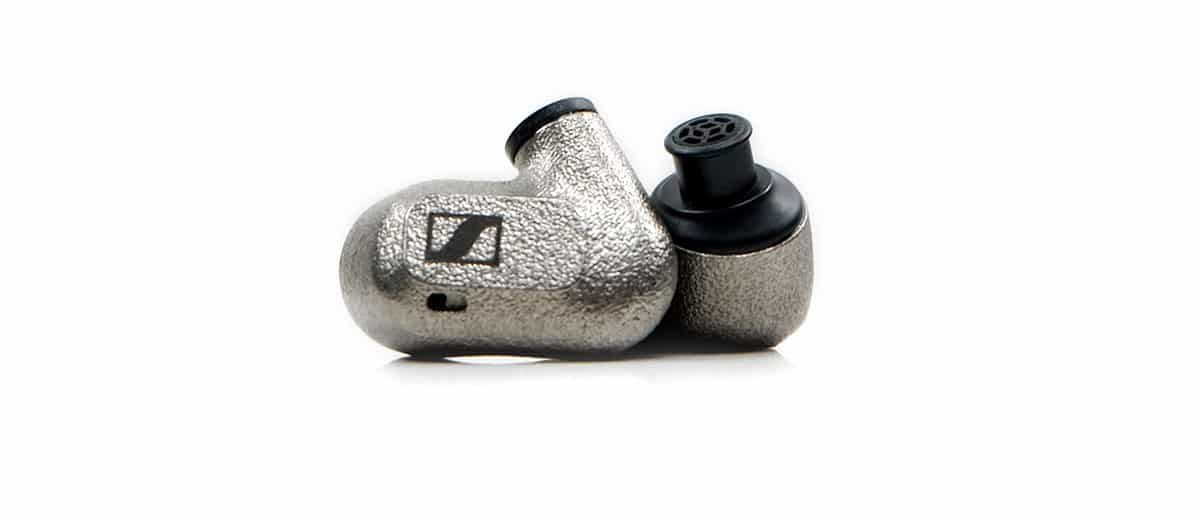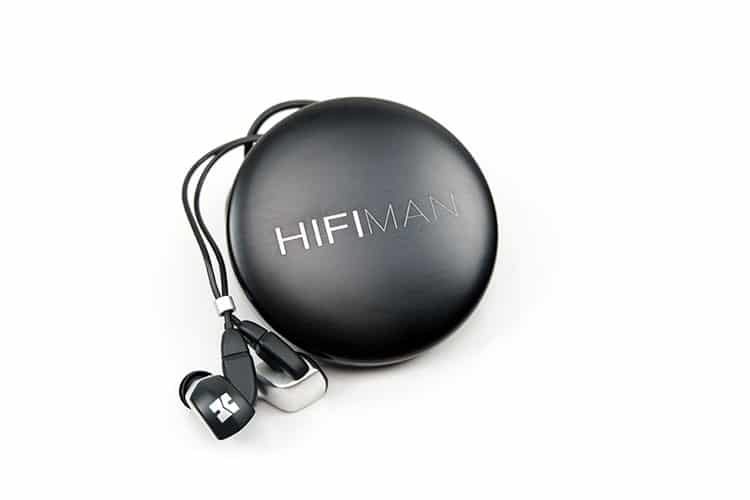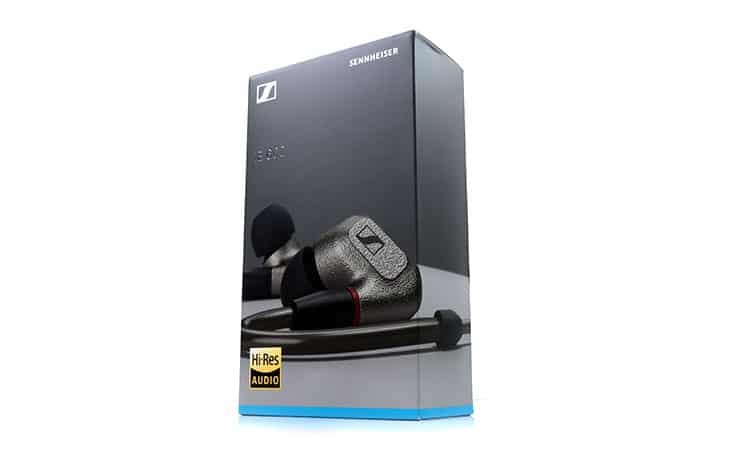Select Comparisons
Sennheiser IE 800
$999 (Now discontinued)
The classic predecessor to the IE 600 for some and though sadly discontinued still held in high regard. We never did a review of it but it has been in the office since 2014 and for some a good comparison to see if worth the upgrade.
Technical
Both monitors actually have a lot of overlap though the driver itself is a bit different. The IE 800 used a 7mm XWB transducer whereas the IE 600 has a slightly larger TrueResponse 7mm version installed.
The original IE 800 was also handmade whereas the newer 7mm IE 600 version is precision production designed. Both still have an internal D2CA or dual resonator chamber acoustical design for improving high-frequency reproduction.
On paper, the original smaller driver is slightly more efficient at 125dB compared to 118dB SPL though the impedance has marginally increased from 16Ω to 18Ω.
In our real-world testing using the 3.5mm LO of the HiBy RS6, I did not detect much of a difference in dynamic and volume levels between these two so the numbers seem to be fairly accurate.

Design
No doubt the IE 600 looks hugely different from the delicate and fine-featured dark aesthetic of the IE 800. On the plus side, its slightly larger size makes the IE 600 easier to handle with the 3D-printed amorphous alloy feeling a lot more robust also.
However, it is hard to ignore just how unique that tiny scratch-resistant ceramic housing of the IE 800 actually is. It also gives you options to wear it straight down or over the ear with its narrower body whereas the IE 600 is strictly an over-the-ear wearing experience.
Comfort-wise, both are fine in the ear with the IE 800 taking up a lot less space though the IE 600 feels more secure. Both rely heavily on the tips to seal which gives the IE 600 an advantage with its more generic tip fit compared to the proprietary tips of the IE 800.
One other huge advantage of the IE 600 is the detachable MMCX cable system which the original IE 800 did not have until the S version was launched.
To be fair, my own IE 800 cable is tough as anything with the para-aramid reinforced finish but the ability to roll cables including the use of a balanced 4.4mm version pushes the IE 600 well ahead.
Performance
There are a couple of tuning differences here and I guess you sum it up as the old way of thinking regarding imaging and spacing in an in-ear versus the new, more Harman Target-centric pitch.
The biggest difference is in the mids with the famous IE 800 2-4k dip pushing back vocals in favor of an expanded bass shelf that starts high in the sub-bass then slowly drops to 100Hz whereafter it stays fairly elevated to 1k.
You get a good deal of underlying warmth here but it also drowns out those dipped mids a little with rock vocals, in particular, struggling to be heard at times.
The IE 600 changes everything about the mids with a more modern 1-3k mild pinna gain and a stronger bass-to-mids separation with 250Hz to 1k dip. The sub-bass is relatively similar in both presence and extension but it does not overpower the mids. Instruments are behind vocals which are now further forward or front and center.
I prefer that style of imaging. It is not overly forward though, I would say a shade north of neutral but nothing overt with upper-mids now more dipped from 3-5k that helps take the sibilant sting out of percussion hits and higher pitching vocals.
The IE 800 ethereal quality to soprano timbre is not present here with the IE 600 sounding denser and smoother in its delivery.
Both do have that 8-10k peak so there is some feistiness in both monitors for upper treble energy. The IE 800’s 5-6k peak is higher so it bleeds a bit more down into the range for me which in turn produces that ethereal glassy quality. Less so with the IE 600 treble though a shade on the dry side.
HIFIMAN RE2000 Silver Edition
$799
The Gold edition still sells for $2000 but you can get the Silver Edition from the HIFIMAN store for $799 which is a lot closer to the IE 600 price point. You can read our Silver Edition overview in more detail here and the RE2000 Gold Review here.
Technical
Both IEMs are single dynamic driver configurations though the RE2000 Silver Edition uses a larger 9.2mm version as opposed to the IE 600 7mm TrueResponse driver.
The HIFIMAN design also incorporates a nanoparticle coating applied to the surface calling it Topology technology. It has a dual purpose of controlling resonance and reducing distortion as well as allowing HIFIMAN to fine-tune the final signature more carefully than regular dynamic drivers.
In a way, the IE 600 internal D2CA or dual resonator chamber acoustical design has the same approach. Its purpose is to also reduce distortion and masking resonance to improve and refine the high-frequency reproduction levels.
On paper, the RE2000 Silver Edition is rated at a fairly high 60Ω impedance level and a not hugely efficient 103dB SPL. That is quite a bit lower than the 118dB of the IE 600 which also requires a lighter 18Ω load.
In our real-world test using the SE 3.5mm output of the iBasso DX240 (AMP 1 MKIII) those numbers feel about right with the HIFIMAN monitors requiring a higher volume level to match the IE 600.
Design
The RE2000 Silver Edition is a substantially larger or bulkier monitor compared to the IE 600. Having said that both do follow that italicized l-shaped form factor though the RE2000 version is much bigger or more dramatic for its 2-pin connector system.
The IE 600 does seem to have a much more robust build quality with that amorphous alloy material whereas this version of the RE2000 is aluminum instead of the heavier brass on the gold edition. It is a lot smoother to the touch compared to the IE 600 with a more elaborate design but perhaps not quite as durable for heavy use. Time will tell.
That larger size does mean the RE2000 does take up a lot more space in your ear but it is still quite ergonomic and comfortable in your ear.
The short nozzle on the HIFIMAN unit does mean tips are more of a factor much like the IE 600 and here I tend to use the triple flange silicone tips for the deepest penetration. Isolation is average on the RE2000 with these tips but it is my preferred tonal signature. The IE 600 has superior isolation with either silicone or foam.
One final note, both are detachable cable IEMs but the system HIFIMAN uses is a bit fiddly for a 2-pin system and only comes with a 3.5mm termination. Here the IE 600 has an edge with both 3.5mm SE and balanced 4.4mm cables included and both follow a standard over-the-ear design with MMCX connectors.
Performance
Side by side using silicone tips on both with the RS6 SE output as the source, the IE 600 runs more neutral to slightly bright whereas the RE2000 Silver is darker and warmer in a nutshell.
It is the treble tuning that will grab your initial impressions in terms of differences. The RE2000 SE rolls off in dB amplitude post-5k taming any treble energy there which in turn defers to the slightly exaggerated mid-bass to lower mids bloom.
You get a smooth warmish overtone combined with a fairly natural 1-2k shelf and a fairly forward upper-mids 4-6k. That means vocals can sound more intimate depending on where they register in the range though lower register vocals on the IE 600 are similarly imaged with itself also having a 1-3k rise.
The IE 600 though has much more treble energy and sparkle with better extension and presence post-6-7k. It dips exactly where the RE2000 SE rises around 4-6k and has a much lower 300Hz to 1k curve.
The sub-bass extension on the IE 600 is slightly higher than the mid-bass punch and the upper bass is flatter also so it doesn’t offer the same level of wooly bloom as the RE2000 through the lower mids.
As a result, the IE 600 sounds a little more balanced imaging-wise compared to the RE2000 SE but timbrally a bit brighter and more strident with the silicone tips. You can smooth that out though with the foam tips to give it a more natural or soft coloration.
Campfire Audio Vega 2020
$899
A highly regarded monitor that was originally launched in 2016 got a 2020 refresh with the Newer Vega 2020 which is still commercially available today. You can read both our original Vega review here and our Vega 2020 review here in more detail.
Technical
Again, another single crossover-free dynamic driver monitor though this time we go up to 10mm with Campfire’s A.D.L.C. diaphragm design.
The original Vega was a smaller driver at 8.5mm but the mechanics of both are quite similar using an amorphous diamond-like carbon coating material on the diaphragm to reduce flex and distortion.
CA’s approach to resonance and lowering distortion is also a bit different from IE 600’s D2CA technology. The Vega 2020 includes a rear venting airflow design and an additional acoustic dampener to regulate airflow as well as a high-density ceramic shell for taming down the potential for unnecessary vibration.
Campfire Audio’s specs are worked slightly differently to Sennheiser for SPL though impedance is directly comparable. The Vega 2020 has a higher resistance level at 36Ω compared to just 18Ω for the IE 600.
SPL is weighted against a benchmark of 94dB with the level of Vrms to reach that dB level as the variable. In this case, it is 19.86 mVrms.
Our real-world testing, therefore, plays a more direct, albeit qualitative role in terms of judging efficiency between these two. Using the 3.5mm PO of the HiBy RS6 again the Vega 2020 comes across as significantly more sensitive than the IE 600 with far less volume required to reach the same level.
Design
The Vega 2020 is a little bit chunkier than the IE 600, certainly deeper though from the side profile both are roughly the same size and will not take up too much room in your ear as a result.
Aesthetics-wise, the Vega 2020 is a gorgeous-looking design with a finely chiseled and smoother white ceramic finish. The IE 600 looks a bit more subdued with its executive grey grippy texture and simpler 3D printed lines. The ceramics also feel as sturdy and as robust as the IE 600 build so I have no concerns about the Vega 2020 durability.
Both are MMCX terminated with stems to the rear and neither has any fit issues with both very comfortable in the ear. The Vega 2020 comes with Final E tips also which are a little bit sturdier in the ear and isolate better than the silicone tips from the IE 600. The isolation levels of the IE 600 foam tips are a lot closer though.
The Vega 2020 only comes with a 3.5mm SE cable though it’s of good quality 4-core 1.32m SPC Litz cable and a fair bit lighter and less microphonic compared to the IE 600 TPU jacketed version. The IE 600 does come with a 4.4mm version which gives it an advantage in my book.
Performance
The Vega 2020 is much the softer and warmer of the two monitors here with the IE 600 offering a comparatively cleaner and slightly brighter tuning.
Much of the Vega 2020 warmth comes from a fairly amplified low-end that has an L-shaped curve down to 1k. It’s big and bold sounding but a little on the slow side and delivers a lot of bloom into the sound signature.
Whereas the IE 600, though similarly extended and sub-bass biased, has less amplitude beyond 50Hz and a much more neutral flatter curve through the lower mids. In short, it has a better level of bass to mids separation and of the two a little more balanced sounding.
The works well for the IE 600’s midrange which, whilst not overly forward sounding, has more room to breathe compared to the Vega mids which feel a little more dipped and not as airy or offer as much tonal contrast. The imaging from the Vega 2020 through the mids is a bit more diffuse and not quite as focused as the IE 600.
The lack of contrast comes from a very relaxed treble tuning from the Vega 2020 compared to the more energetic and forward nature of the IE 600 upper treble. The IE 600 highs color the midrange timbre a lot more giving it a cleaner but slightly drier edge.
The Vega 2020 is a lot more liquid in its tone through the highs, with a stronger even-harmonic bias. It’s a lot more forgiving also for the upper mids as a result but it’s a shade darker sounding at the same time.
Our Verdict
The Sennheiser IE 600 is probably the most credible-sounding monitor they have released in a while. Granted, I have not heard the rest of the new releases but compared to their classics the dynamic driver tuning is relevant, modern, and more engaging.
It hits all the right spots in terms of convincing depth, and clear midrange performances with the only question being how much sparkle you want from your treble. It is a feisty so and so with the silicones but just right with the foams for my preferences. Get your matching source just right and it’s a very pleasant listen indeed.
Kudos also for Sennheiser throwing in that detachable balanced cable alongside the SE version also. One of my irritations with the fixed cable of the IE 800 is now gone.
Can it compete with everything else out there? At this price point, it is a most definite yes for sound quality. It is an understated-looking IEM but I recommend a demo if you enjoy dynamic driver monitors.
Sennheiser IE 600 Specifications
- Frequency response: 4 – 46,500 Hz
- Sound pressure level (SPL): 118 dB at 1 kHz, 1 Vrms
- Total harmonic distortion (THD): <0.06% (1 kHz, 94 dB)
- Cable length: 125 cm
- Connectors: (+) MMCX
- Impedance: 18 Ω
- Attenuation: 25dB




